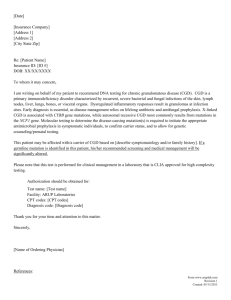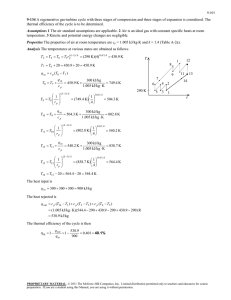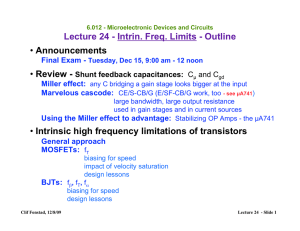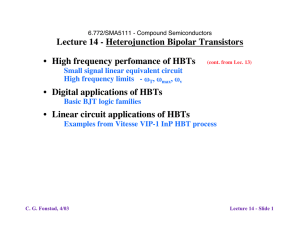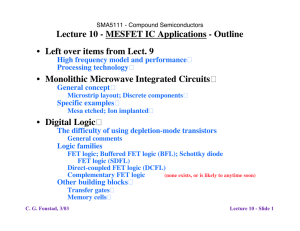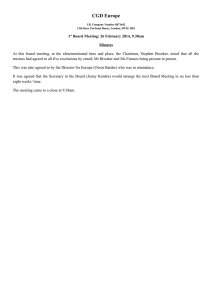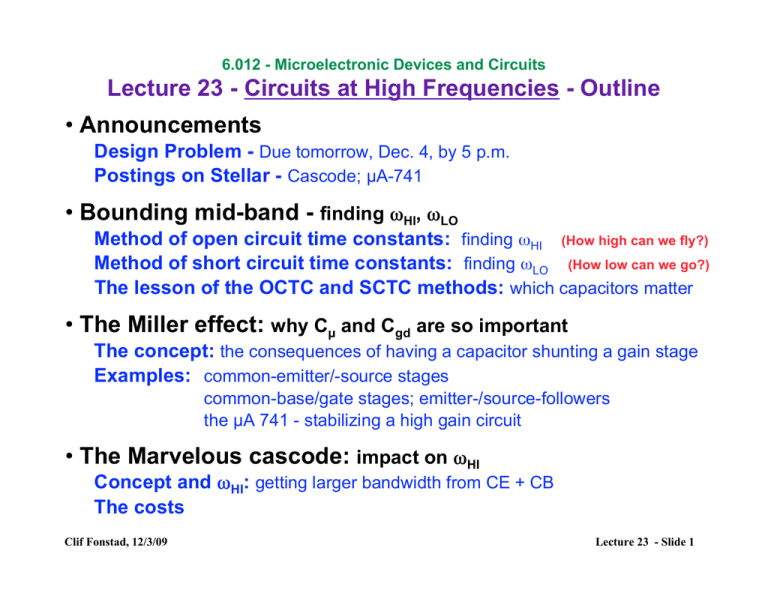
6.012 - Microelectronic Devices and Circuits
Lecture 23 - Circuits at High Frequencies - Outline
• Announcements
Design Problem - Due tomorrow, Dec. 4, by 5 p.m.
Postings on Stellar - Cascode; µA-741
• Bounding mid-band - finding ωHI, ωLO
Method of open circuit time constants: finding ωHI (How high can we fly?)
Method of short circuit time constants: finding ωLO (How low can we go?)
The lesson of the OCTC and SCTC methods: which capacitors matter
• The Miller effect: why Cµ and Cgd are so important
The concept: the consequences of having a capacitor shunting a gain stage
Examples: common-emitter/-source stages
common-base/gate stages; emitter-/source-followers
the µA 741 - stabilizing a high gain circuit
• The Marvelous cascode: impact on ωHI
Concept and ωHI: getting larger bandwidth from CE + CB
The costs
Clif Fonstad, 12/3/09
Lecture 23 - Slide 1
!
The impact of Q13' and Q13 on the voltage gains
We added transistor Q13
to the left side of the DP
second gain stage (the
Current Mirror), and said
it has no effect on the Avd
or Avc of this stage. In
fact it does have some
impact on the commonmode voltage gain. The
following few sides look
at this impact.
+ 1.5 V
Q12
Q11
A
Q16
Q13'
Q13
Q17
We find that now:
#
gm11 &
Avc " %1+
(=
$ gm13' '
" 1.5
#
2Vthermal &
%1+
(
V
)
V
$
GS11
T11 '
Q14
Q15
- 1.5 V
Remember that it is possible to make the bias currents in the two legs of the mirror (Q11/Q14 and
Q12/Q15) different by making the transistors widths different.
Clif Fonstad, 12/3/09
Lecture 23 - Slide 2
The impact of Q13' and Q13 on the voltage gains, cont.
V+
In the design problem we
have a current mirror stage
with a level shift diode in
each leg. The bias currents
of the two legs can also be
different.
We can do an
LEC analysis of
this circuit in the
same way we did
without the two
diodes. We start
with the LEC for
the left side and
find vinner:
Q1
D1'
Q3
+
vIC + vID /2
-
+
v ic +v id /2 = v gs3
-
Q2
D1
+
+
Q4
+
vIC - vID /2
-
vINNER
-
vOUT
-
Vgd1’
gm3v gs3
go3
go1
gm1
+
v inner
-
LEC for the left side
Clif Fonstad, 12/3/09
Lecture 23 - Slide 3
The impact of Q13' and Q13 on the voltage gains, cont.
The left side LEC gives:
v inner
%
v (
" # (1# $ )' v ic + id *
&
2)
with
rd1' + 2rm 3 2go3 %
gm 3 (
$ +
=
'1+
*
ro3
gm 3 & 2gd1' )
Next we analyze the right side LEC:
!
+
v ic -v id /2 = v gs4
-
go4
gel
gm4v gs4
+
gd1
v out
-
go2
gm2v inner
LEC for the right side
To see the impact of gd1 on this side, apply one source at a time and
superimpose the results:
+
v ic -v id /2 = v gs4
-
gm4vgs4 alone:
gm4v gs4
go4
gel
+
gd1
v out1
-
go2
go4
gel
+
gd1
v out2
-
go2
gm2vinner alone: +
v ic -v id /2 = v gs4
Clif Fonstad, 12/3/09
gm2v inner
Lecture 23 - Slide 4
The impact of Q13' and Q13 on the voltage gains, cont.
Writing ro4||rel as ro4*, and doing this we find:
v out = v out1 + v out 2 =
=
!
(r
"
o4
+ ro2 + rd )
gm 4 v gs4
ro2 ro4"
# "
(1# $ ) gm 2v gs2
(ro4 + ro2 + rd )
(ro2 + rd ) ro4"
%
%
v id (
ro2 ro4"
v id (
g
v
#
#
1#
$
g
v
+
'
*
'
*
(
)
m4
ic
m2
ic
"
"
&
2)
2)
(ro4 + ro2 + rd ) &
(ro4 + ro2 + rd )
Next look at the terms involving vid and vic terms separately:
vid:
#
%
(
#
( ro2 + rd ) ro4
"' #
gm 4
'&( ro4 + ro2 + rel )
vic:
!
(ro2 + rd ) ro4"
Note: Analysis
sets gm1 = gm3,
gm2 = gm4, go1 =
go3, go2 = go4.
ro2 ro4# (2 " $ )
ro2 ro4
v id
v id
*
+ #
1"
$
g
+
g
( ) m2
m4
#
2
r
+
r
+
r
r
+
r
+
r
*)
( o4 o2 d )
( o4 o2 d ) 2
#
% ( r + r ) r#
(
#
r
+
$
r
r
r
r
(
)
o2 o4
" ' #o2 d o4 gm 4 " # o2 o4
gm 4 v ic
(1" $ ) gm 2 * v ic = d#
'&( ro4 + ro2 + rd )
*)
(ro4 + ro2 + rd )
(ro4 + ro2 + rd )
Ultimately we find:
v out
!
$ gm1 ' (v in1 + v in 2 )
v in1 # v in 2 )
2 gm 4
(
"
# &1+
)
2
2
(2go4 + gel )
% gd1' (
≈ unchanged by adding diodes
Clif Fonstad, 12/3/09
!
≈ 1.5, increased from ≈1 by adding diodes
Lecture 23 - Slide 5
Mid-band, cont: The mid-band range of frequencies
In this range of frequencies the gain is a constant, and the
phase shift between the input and output is also constant
(either 0˚ or 180˚).
log |A
vd |
Mid-band Range
!LO
!b
!a !d
!c
!LO *
!HI * !HI
!4
log !
!5 !2!1 !3
All of the parasitic and intrinsic device capacitances
are effectively open circuits
All of the biasing and coupling capacitors are
effectively short circuits
Clif Fonstad, 12/3/09
Lecture 23 - Slide 6
Bounding mid-band: frequency range of constant gain and phase
Cgd
g
Common
Source
+ +
v gs
v
rt
V+
+
vt
in
-
Cgs
gmv gs
go
gsl
s,b
-
CO
+
v out
gel
CS
gob
-
LEC for common source stage with all the capacitors
vout
-
+
vin
-
CO
+
d
Biasing capacitors:
(CO, CS, etc.)
IBIAS
Device capacitors:
CE
(Cgs, Cgd, etc.)
typically in mF range
effectively shorts above ωLO
typically in pF range
effectively open until ωHI
Mid-band frequencies fall between: ωLO < ω < ωHI
V-
g
+
vt
-
rt
+
v in = v gs
s,b
d
+
gmv gs
go
v out
-
gl
s,b
Common emitter LEC for in mid-band range Note: gl = gsl + gel
Clif Fonstad, 12/3/09
What are ωLO and ωHI?
Lecture 23 - Slide 7
Estimating ωHI - Open Circuit Time Constants Method
Open circuit time constants (OCTC) recipe:
1. Pick one Cgd, Cgs, Cµ, Cπ, etc. (call it C1) and assume all
others are open circuits.
2. Find the resistance in parallel with C1 and call it R1.
3. Calculate 1/R1C1 and call it ω1.
4. Repeat this for each of the N different Cgd's, Cgs's, Cµ's,
Cπ's, etc., in the circuit finding ω1, ω2, ω3, …, ωN.
5. Define ωHI* as the inverse of the sum of the inverses of
the N ωi's:
ωHI* = [Σ(ωi)-1]-1 = [ΣRiCi]-1
6. The true ωHI is similar to, but greater than, ωHI*.
Observations:
The OCTC method gives a conservative, low estimate for ωHI.
The sum of inverses favors the smallest ωi, and thus the
capacitor with the largest RC product dominates ωHI*.
Clif Fonstad, 12/3/09
Lecture 23 - Slide 8
Estimating ωLO - Short Circuit Time Constants Method
Short circuit time constants (SCTC) recipe:
1. Pick one CO, CI, CE, etc. (call it C1) and assume all others
are short circuits.
2. Find the resistance in parallel with C1 and call it R1.
3. Calculate 1/R1C1 and call it ω1.
4. Repeat this for each of the M different CI's, CO's, CE's, CS's,
etc., in the circuit finding ω1, ω2, ω3, …, ωM.
5. Define ωLO* as the sum of the M ωj's:
ωLO* = [Σ(ωj)] = [Σ(RjCj)-1]
6. The true ωLO is similar to, but less than, ωLO*.
Observations:
The SCTC method gives a conservative, high estimate for ωLO.
The sum of inverses favors the largest ωj, and thus the
capacitor with the smallest RC product dominates ωLO*.
Clif Fonstad, 12/3/09
Lecture 23 - Slide 9
Summary of OCTC and SCTC results
log |A
vd |
Mid-band Range
!LO
!b
!a !d
!c
!LO *
!HI * !HI
!4
log !
!5 !2!1 !3
• OCTC:
1.
2.
3.
an estimate for ωHI
ωHI* is a weighted sum of ω's associated with device capacitances:
(add RC's and invert)
Smallest ω (largest RC) dominates ωHI*
Provides a lower bound on ωHI
• SCTC:
1.
2.
3.
an estimate for ωLO
ωLO* is a weighted sum of w's associated with bias capacitors:
(add ω's directly)
Largest ω (smallest RC) dominates ωLO*
Provides a upper bound on ωLO
Clif Fonstad, 12/3/09
Lecture 23 - Slide 10
ωHI for the Common Source - the full treatment
Cgd
g
rt
+
vt
-
+
v in = v gs
d
+
Cgs
go
gmv gs
-
The full gain expression is:
{( j" ) C
2
gl
s,b
s,b
Av ( j" ) =
v out
-
#gt ( gm # j"Cgd )
Cgd + j" [( gl + go )Cgs + ( gl + go + gt + gm )Cgd ] + ( gl + go ) gt
gs
}
There are two poles (call them ω1 and ω2), and one zero (call it ω3):
"1 = gt [Cgs + ( gl + go + gt + gm ) rl' Cgd ]
!
with rl' # ( gl + go )
$1
" 2 = ( gl + go ) Cgd + ( gl + go + gt + gm ) Cgs
" 3 = gm Cgd
Upon examination of these three expressions we find that ω1 << ω2,
ω3, so ω1 is clearly the dominant pole, and ωHI is effectively ω1.
!
Clif Fonstad, 12/3/09
Note: Cdb has been neglected to keep
things simpler; it is very small.
Lecture 23 - Slide 11
ωHI for the Common Source - the OCTC method
Cgd
g
+
vt
-
rt
+
v in = v gs
d
+
Cgs
gmv gs
-
go
v out
-
gl
s,b
s,b
The resistance, Rgs, seen by Cgs with Cgd removed is 1/gt, so
" gs = gt Cgs
That seen by Cgd with Cgs removed, Rgd, is (gl'+gt+gm)/gtgl', so
" gd = gt [ g'l + gt + gm ] rl' Cgd
! method we estimate ωHI as
Using the OCTC
[
#1
" *HI = (" #1
Cgs + ( g'l + gt + gm ) rl' Cgd
gs + " gd ) = gt
#1
]
!
This is actually
identical to the dominant pole, ω1, found using
the full analysis.
!
Clif Fonstad, 12/3/09
Lecture 23 - Slide 12
ωHI for the Common Source: the Miller effect
In both of our analyses we note that in the dominant term Cgd is
multiplied by the factor (gl'+gt+gm)rl'. Noting (1) that typically it
is true that gm >> gt, and (2) that -gmrl' is the mid-band voltage
gain, Av, of the amplifier, we see that this factor can be approximated as one minus the voltage gain of the stage, i.e.:
(g + g + g )r
'
l
t
m
'
l
= [1+ ( gt + gm ) rl' ] " [1+ gm rl' ] = (1# Av )
If the voltage gain is large, then in effect Cgd looks bigger from
the input side of the circuit than it really is, i.e. (1 - Av)Cgd:
g
d
!
+
vt
-
rt
+
v in = v gs
s,b
Cgs
Cgd (1-Av )
gmv gs
go
+
v out
-
gl
s,b
This "magnification" of a capacitor bridging the input and the
output of a voltage amplifier, as Cgd does here, by |Av| is called
the Miller effect.
Clif Fonstad, 12/3/09
Lecture 23 - Slide 13
The Miller effect (general)
Consider an amplifier shunted by a capacitor, and consider
how the capacitor looks at the input and output terminals:
Cm
+
vin
-
Av
iin = Cm
+
!vin
-
+
vout
d [(1" Av )v in ]
dt
(1-Av)Cm
Cin looks much
bigger than Cm
(1-Av)vin
iin +
+
+
vin Cm vout = A vvin
= (1" Av )Cm
Cm
dv in
dt
Note: Av is negative
+
vout
-
Cm
(1" Av )
Av
# Cm
Cout looks like Cm
Clif Fonstad, 12/3/09
Lecture 23 - Slide 14
!
The Miller effect: Miller capacitors in other basic stages
Common drain or source follower
g
Cgd
+ +
rt
v gs
Cgs
gmv gs
+
v in vt
s,b
+ s,b
gl v out
-
d
go
Repositioning Cgd makes the situation clearer:
g
rt
+
vt
-
+
v in
+
v gs
Cgd
Clif Fonstad, 12/3/09
d
Cgs
s,b
gmv gs
+ s,b
gl v out
-
go
Cgs is in the
Miller position,
but the voltage
gain is one so
there is no
Miller effect.
Lecture 23 - Slide 15
The Miller effect: Miller capacitors in other basic stages
Common gate, substrate grounded
The way one often sees common gate stages.
go
rt
s
d
+
+
v in
= v sg
-
vt
-
(gm + gmb )v sg
Cgs +Cbs Cgd +Cbd
g,b
+
v out
-
gl
g,b
No Miller effect, just as in common-base.
Common gate, substrate shorted to source
This is the connection used in the design problem.
Cbd
rt
+
vt
-
go
s,b
+
v in
= v sg
g
d
gmv sg
Cgs
Cgd
+
v out
-
gl
g
Now Cbd shows up in the Miller position.
Clif Fonstad, 12/3/09
-
But note that the gain is positive, so (1-Av) is negative and Cgs||(1-Av)Cbd
is < Cgs, i.e. the Miller effect helps!
Lecture 23 - Slide 16
The cascode when the substrate is grounded:
VBS ≠ 0 (alternative to VBS = 0 as
V+
in the design problem circuit)
Schematic:
Commonsource
Q1
Q2
+
V IN+vin
-
gl
Commongate
+
V OUT+vout
-
VCommon-gate L.E.C. when VGS ≠ 0:
go
d
g,b
+
(gm + g mb )vsg
vin
= vsg
s
s
Clif Fonstad, 12/3/09
* The effective
transconductance
is increased by the
substrate
generator term.
Lecture 23 - Slide 17
The cascode when the substrate is grounded, cont:
VGS ≠ 0
ro2
L.E.C.:
+
vgs1
gm1vgs1
ro1
Av =
v out
=
v in g +
l
-
(gm2+gmb2 )vgs2
vgs2
+
"gm1
g01
(gl + g02 )
(gm 2 + gmb 2 + g02 )
+
rl
vout
#o
"gm1
gl + g01
g02
(gm 2 + gmb 2 )
The equivalent transistor, QCC:
!
g
d
+
vgsCC
s
gmCC vgsCC
roCC
-
Clif Fonstad, 12/3/09
gm,CC = gm1
s
VA,CC " VA1
ro,CC " r01
go2
(gm 2 + gmb 2 )
The output resistance is even higher!
!
(gm 2 + gmb 2 )
go2
Lecture 23 - Slide 18
The cascode when the substrate is grounded, cont:
High frequency issues:
L.E.C. of cascode: can't use equivalent transistor idea here
because it didn't address the issue of the C's!
ro2
Cgd1
g1
+
vgs1
gm1vgs1
s1,b1,b2
Cgs1
ro1
Voltage gain ≈ -1 so
minimal Miller effect.
d2
+
d1,s2,b2
-
(gm2+gmb2 )vgs2
Cgd2 +Cbd2
Cdb1 +Cgs2 +Cbs2
vout
vgs2
+
s1,b1,g2,b2
rl
g2,b2
Voltage gain ≈ gmrl,
without Miller effect.
Common-source gain without the Miller effect penalty!
Clif Fonstad, 12/3/09
Lecture 23 - Slide 19
Multi-stage amplifier analysis and design: The µA741
Figuring the circuit out:
Emitter-follower/
common-base "cascode"
differential gain stage
EF
CB
The full schematic
© Source unknown. All rights reserved.
This content is excluded from our Creative Commons license.
For more information, see http://ocw.mit.edu/fairuse.
Push-pull
output
Current mirror load
Darlington commonemitter gain stage
Simplified schematic
© Source unknown. All rights reserved. This content is excluded from our Creative Commons license.
For more information, see http://ocw.mit.edu/fairuse.
Clif Fonstad, 12/3/09
Another interesting discussion of the µA741:
http://en.wikipedia.org/wiki/Operational_amplifier
Lecture 23 - Slide 20
Multi-stage amplifier analysis and design: The µA741
The chip: a bipolar IC
Capacitor
Resistors
Transistors
Bonding pads
© Source unknown. All rights reserved. This content is excluded from our Creative Commons license.
For more information, see http://ocw.mit.edu/fairuse.
Clif Fonstad, 12/3/09
Lecture 23 - Slide 21
Multi-stage amplifier analysis and design: The µA741
Why is there a capacitor in the circuit?: the added capacitor
introduces a low
frequency pole.
Without it the gain
is still greater than 1
when the phase shift
exceeds 180˚ (dashed
curve). This can result
in positive feedback
and instability.
Clif Fonstad, 12/3/09
Low
frequency
pole
With it the gain
is less than 1 by
the time the phase
shift exceeds 180˚
(solid curve).
Lecture 23 - Slide 23
6.012 - Microelectronic Devices and Circuits
Lecture 23 - Circuits at High Frequencies - Summary
Bounding mid-band - finding ωHI, ωLO
ωHI: Find the resistance in parallel with each device capacitor assuming the
such device capacitors are open circuits, calculate all the RC time
constants, and add them. The inverse is a lower bound on ωHI.
ωLO: Find the resistance in parallel with each bias capacitor assuming the
other such capacitors are short circuits, calculate all the 1/RC frequencies,
and add them. This sum is an upper bound on ωLO.
The Miller effect: why Cgd is so important
The concept: a capacitor shunting a gain stage looks larger by (1 - Av)
Examples: (1) The Miller effect magnifies Cgd in common-source stages;
(2) There is no significant Miller effect impact on common-gate stages or
on source-followers; (3) The Miller effect is used in the µA741 to get the
relatively large capacitor needed to stabilize it.
The Marvelous cascode
Concept and ωHI: Current gain from a CS stage and voltage gain from
a CG to circumvent the Miller effect.
Output resistance: significantly larger than CS alone.
The costs: The added device increases the voltage distance away from
the rails and limits voltage swings
Clif Fonstad, 12/3/09
Lecture 23 - Slide 24
MIT OpenCourseWare
http://ocw.mit.edu
6.012 Microelectronic Devices and Circuits
Fall 2009
For information about citing these materials or our Terms of Use, visit: http://ocw.mit.edu/terms.

